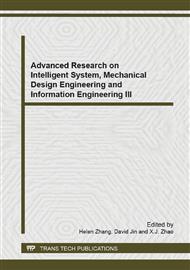[1]
D. H. Jee, K. J. Kang. A method for optimal material selection aided with decision making theory, Materials & Design Vol. 21 (2000), pp.199-206.
DOI: 10.1016/s0261-3069(99)00066-7
Google Scholar
[2]
Deng Y.M., Edwards K.L. The role of materials identification and selection in engineering design, Materials & Design, Vol. 28, (2007) pp.131-139.
DOI: 10.1016/j.matdes.2005.05.003
Google Scholar
[3]
Hu-Chen Liu, Long Liu, Jing Wu. Material selection using an interval 2-tuple linguistic VIKOR method considering subjective and objective weights. Materials & Design, Vol. 52, (2013), pp.158-167.
DOI: 10.1016/j.matdes.2013.05.054
Google Scholar
[4]
P. Chatterjee, V. M. Athawale, S. Chakraborty. Materials selection using complex proportional assessment and evaluation of mixed data methods, Materials & Design, Vol. 32 (2011), pp.851-860.
DOI: 10.1016/j.matdes.2010.07.010
Google Scholar
[5]
A. Shanian, O. Savadogo TOPSIS multiple-criteria decision support analysis for material selection of metallic bipolar plates for polymer electrolyte fuel cell. Journal of Power Sources, Vol. 159, (2006), pp.1095-1104.
DOI: 10.1016/j.jpowsour.2005.12.092
Google Scholar
[6]
A. Shanian, O. Savadogo A material selection model based on the concept of multiple attribute decision making, Materials & Design, Vol. 27 (2006) pp.329-337.
DOI: 10.1016/j.matdes.2004.10.027
Google Scholar
[7]
R. V. Rao. Decision making methodology for material selection using an improved compromise ranking method. Materials & Design, Vol. 29 (2008) p.1949-(1954).
DOI: 10.1016/j.matdes.2008.04.019
Google Scholar
[8]
R. J. Girubha, S. Vinodh. Application of fuzzy VIKOR and environmental impact analysis for material selection of an automotive component. Materials & Design, Vol. 37 (2012), pp.478-486.
DOI: 10.1016/j.matdes.2012.01.022
Google Scholar
[9]
A. Kasaei, A. Abedian, A. S. Milani. An application of Quality Function Deployment method in engineering materials selection. Materials & Design, Vol. 55 (2014), pp.912-920.
DOI: 10.1016/j.matdes.2013.10.061
Google Scholar
[10]
P. Karande and S. Chakraborty. Application of multi-objective optimization on the basis of ratioanalysis (MOORA) method for materials selection. Materials & Design, Vol. 37 (2012), pp.317-324.
DOI: 10.1016/j.matdes.2012.01.013
Google Scholar
[11]
J. Jiang, Y. W. Chen, K. W. Yang, TOPSIS with fuzzy belief structure for group belief multiple criteria decision making, Expert Systems with Applications, Vol. 38 (2011), pp.9400-9406.
DOI: 10.1016/j.eswa.2011.01.128
Google Scholar
[12]
R. V. Rao, B. K. Patel, A subjective and objective integrated multiple attribute decision making method for material selection, Materials & Design, Vol. 31 (2010), pp.4738-4747.
DOI: 10.1016/j.matdes.2010.05.014
Google Scholar
[13]
A. Jahan, M. Bahraminasab, K. L. Edwards. A target-based normalization technique for materials selection. Materials & Design, Vol. 35 (2012), pp.647-654.
DOI: 10.1016/j.matdes.2011.09.005
Google Scholar
[14]
M. C. Thomas, J. A. Thomas, Elements of Information Theory, 2nd Edition, John Wiley & Sons, Inc., Hoboken, New Jersey, (2006).
Google Scholar
[15]
M. Zhao, W. H. Qiu, B. S. Liu, Relative entropy evaluation method for multiple attribute decision making, Control and Decision, Vol. 25 (2010) pp.1098-1100.
Google Scholar


